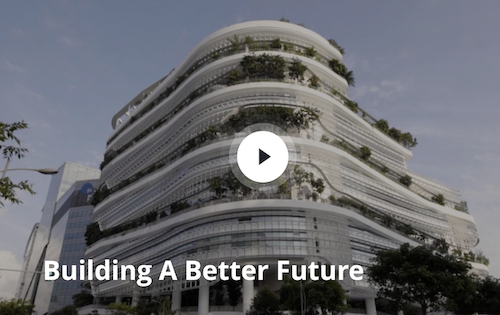Innovation in the sustainable building sector
Produced by BBC StoryWorks, the World Green Building Council (WorldGBC) films explore how sustainable buildings can address climate, health and well-being as well as resource efficiency issues.

World Green Building Council launched a series of mini-documentary style films on 11 November 2020, highlighting the impact of buildings on the environment and human health as well as the work of organisations around the world to counter this.
Produced by BBC StoryWorks Commercial Productions, Building A Better Future explores the profound impact buildings can have on the quality of people’s lives and the crucial role buildings can play in tackling climate change.
According to the World Health Organization, people spend on average 90 per cent of their time indoors so it is imperative that the buildings they work, rest and play in benefit their health. Buildings are responsible for almost 40 per cent of energy-related global carbon emissions and the global building stock is set to double by 2050, so it is more critical than ever that our buildings also contribute to the health of the environment.
Through a diverse set of voices from across the sustainable buildings movement, this series showcases the ways in which organisations are successfully unlocking the benefits of sustainable buildings, and what that means for us all. The series also explores how we can accelerate the clean energy transition, reach our climate goals and support a Green recovery from the COVID-19 pandemic.
Our living conditions play a critical role in preventing the spread of disease. Medical experts even say that Green buildings can help us in our fight against coronavirus. These types of buildings preserve natural resources, prioritise good ventilation and are highly energy-efficient. They reduce both waste and air pollution and are built using non-toxic, sustainable materials.
“During coronavirus, nobody wants recirculated air in offices, gyms and schools. If a building doesn’t improve the health of occupants, then it is not a sustainable building,” commented Catriona Brady, head of Better Places for People at the World Green Building Council.
Balancing the demand for fresh air ventilation during the pandemic with the need to conserve energy is a difficult task.
“We’re doing the best we can right now to improve our indoor air quality and keep our air moving about, but the risk is insanely high uses of energy. In the current climate, it is much more challenging to meet our criteria for healthy levels of ventilation [while] working towards net zero carbon energy use,” said Brady.
Brady hopes that the pandemic will change the way we build and place greater emphasis on health and wellbeing in the construction industry. Future buildings will be installed with sensors to monitor indoor air quality and CO2 levels as well as hands-free lifts to improve hygiene, she said.
“For all new buildings, everything you can do to maximise health and well-being is going to be fundamental.”
“A Green building is like a giant face mask,” said Dr Ho Nyok Yong, president of the Singapore Green Building Council. He explains that many commercial buildings in Singapore use smart sensors to track the number of people present and adjust the amount of fresh air entering the building accordingly. By 2030, Singapore aims for 80 per cent of its buildings to be green.
“As the world adapts to COVID-19 and prepares for COP26, we are proud to launch a series that brilliantly highlights the climate and human health challenges we face and the built environment organisations tackling them. We hope the series will serve as an educational tool for the building and construction sector around the world and a source of inspiration for others,” shared Cristina Gamboa, CEO, World Green Building Council.

